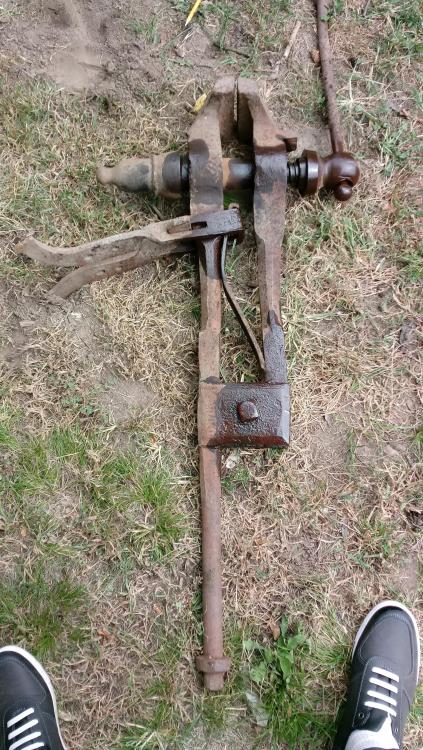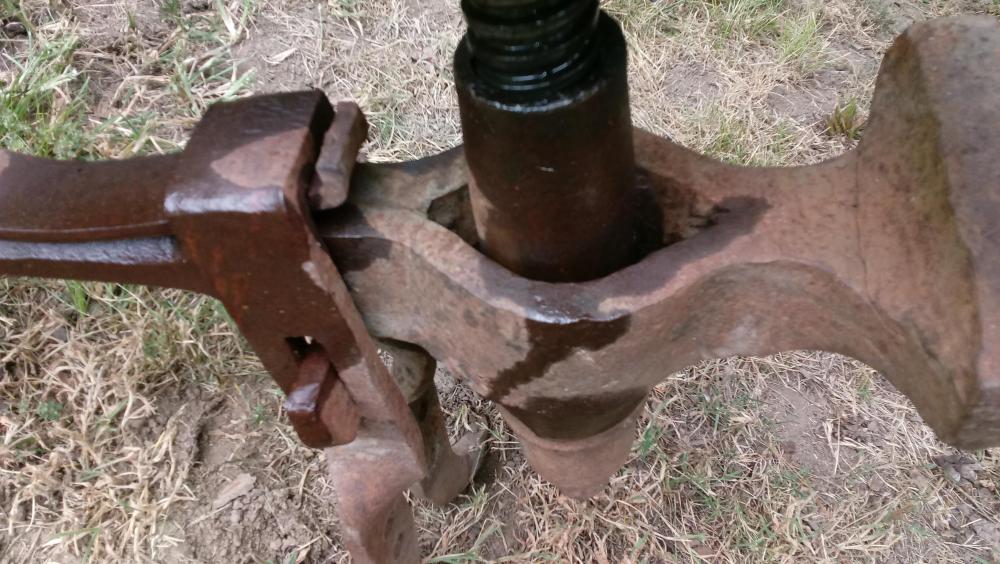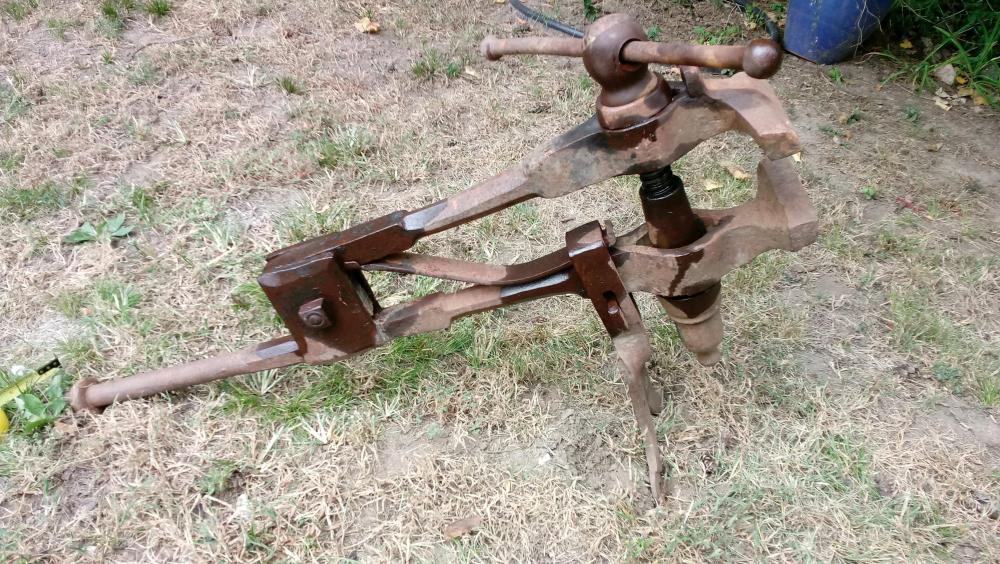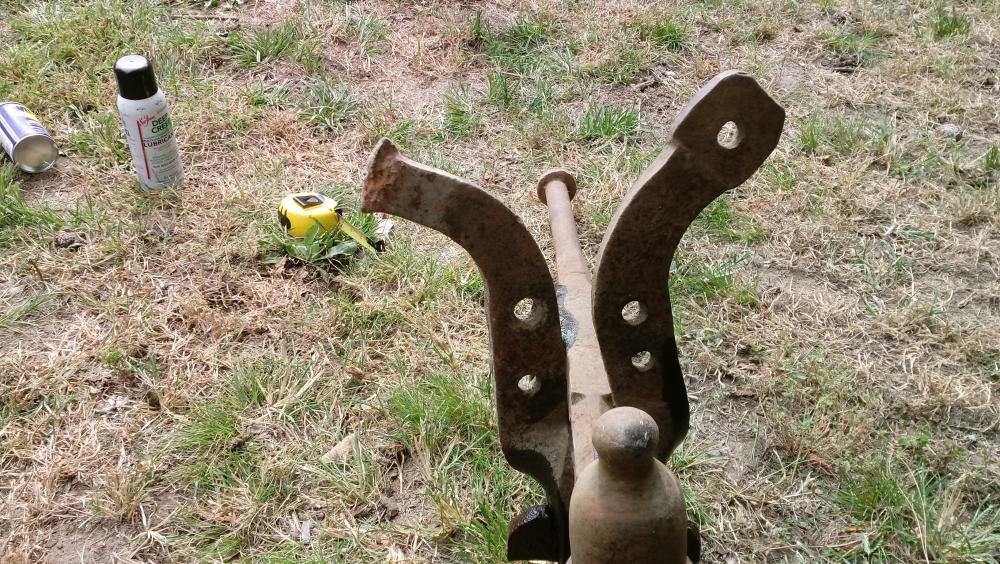-
Posts
152 -
Joined
-
Last visited
Content Type
Profiles
Forums
Articles
Gallery
Downloads
Events
Everything posted by SFC Snuffy
-

Let’s see some fire pokers
SFC Snuffy replied to Jasent's topic in Blacksmithing, General Discussion
That's a really nice-looking design! Stylish, but functional. -
I see! If the top of the spring is anchored properly, the bottom will kick out and press against the movable jaw. Thank you, gentlemen.
-
Recently picked this one up. It needs some work, the which I've never really done before, but it would be a shame to let it go to waste. It's about 41" overall, with 6" jaws, but no visible markings. I'm not as spry as I used to be, but I'm guessing it weighs about 100 lbs. The screw works nice and smooth, but the spring doesn't. Any suggestions for remedying that??
-

What did you do in the shop today?
SFC Snuffy replied to Mark Ling's topic in Blacksmithing, General Discussion
Ted, that's a great-looking leaf! I've never used a leafing swage, but I thought I knew how. Yours seems really deep and narrow, though. Would you happen to have a pic showing the swage/swedge with a leaf on it? I.e. in use? -
Even with the loss of momentum at the bottom of the treadle hammer's stroke, it has both more kinetic energy (KE = 1/2 mass x velocity^2) and more momentum (mass x velocity) simply because the head is so heavy. Because the KE equation is so heavily weighted toward velocity, it doesn't seem as impressive, but I suspect that momentum plays a bigger role in forge work... otherwise we'd all be swinging 4 oz. hammers as fast as we could.
-

How strong is forge welding
SFC Snuffy replied to Glenn's topic in Blacksmithing, General Discussion
As with any hypothetical situation, you must make some assumptions. If the forge weld is perfect, or ideal, then there is no weld seam. The material is homogeneous and strength will be rated according to the cross-section of the material, yes? Mokume-gane techniques can produce solid-state welds even between disparate metallic solids. I don't know enough about modern welding to to know how that compares. My limited experience with a MIG welder leads me to believe that you can't effect a large lap weld in the same way that you can forge weld, but I could easily be mistaken. -

Very new to this...
SFC Snuffy replied to brickforgebeginner's topic in Blacksmithing, General Discussion
Before you commit to a certain type of forge, it may be useful to browse around the forge sections of the forums, bot solid-fuel and gas. The aforementioned JABOD-style forge is designed to be inexpensive and quick to set up. A propane forge can be cheaper to operate in the long run, but will require some cash outlay in materials and labor up front. Is there something about propane that appeals to you? Given the materials and skills that you have available, and the risk you're prepared to accept, other options may be a better fit for you. EDITED TO ADD: With regards to the leaf blower, you can pull it back from - or even out of - the forge so that it's just blowing air AT the fire, rather than dumping all of that too-great volume into the forge. It's not a perfect solution, but it should cut your fuel consumption and oxidation rates down a bit. -

What did you do in the shop today?
SFC Snuffy replied to Mark Ling's topic in Blacksmithing, General Discussion
Today, I beat a couple of 3/4" Grade 5 hex bolts into mini bearded axe heads, with an eye to turning them into some of those nifty bottle openers. I also flattened out a piece of angle iron and did some preliminary trimming with a hot cut to turn it into a feather. The bottle openers will be for a long-time friend of mine, the feather I'm making just because. I'm sure one of my pagan acquaintances will covet it if I can get it to come out the way I'd like it to. No pictures, I'm afraid. Everything was over- or under-exposed. -

Very new to this...
SFC Snuffy replied to brickforgebeginner's topic in Blacksmithing, General Discussion
Is that a leaf blower? I suspect it's providing far too much air, which increases oxidation on your stock, increases fuel consumption, and can actually make your fire colder (you're providing more air than the fuel can use). The "Solid Fuel Forge" section of this site, found here, has a great many excellent threads about different aspects of a home-made forge. Start with the JABOD thread and go from there. If knife- and blade-making is your focus, the bladesmithing forum is here, though you should be prepared for experienced smiths to tell you that you have a lot of skills that should be practiced before you try making a knife. Aside from that, your paracord wraps look good. As long as you're experimenting, start with different pre-forms and see what they turn into when you forge in your bevels. Your grinds and surface finish look a little rough, but maybe that's not a big deal for a practice piece. Welcome aboard! -
I'm at the opposite end of the experience spectrum from most of you, having only been smithing once a week for about a year-and-a-half. For me, my "finished" pieces are only now started to be not disappointing. I endeavor to forge a piece (and we're talking simple hooks, nails, bottle openers, etc.) to the best of my abilities and get it as smooth and regular as I can. I have had friends tell me that they appreciate the irregularities, hammer marks from miss-hits, and other "character marks" as proof of its hand-made origins. One person told me that if she wanted hooks that looked identical, she'd buy them from a store and that's why she really liked my work. Talk about damning with faint praise! I appreciate the aesthetics of pieces with intentional tool-marks, but for me I desire to forge a piece that's smooth, scale-free, regular in its angles and curves and essentially indistinguishable from one that's mass-produced. Well... It might be more accurate to say that I'd like to get my skill set to that level. Once there, I might decide to leave some hammer marks! Or not. Torbjörn Åhman's work, from his YouTube channel, really inspires me as someone that wants to make tools. The clean lines and smooth finish of his tools and projects is what I aspire to emulate.
-

What did you do in the shop today?
SFC Snuffy replied to Mark Ling's topic in Blacksmithing, General Discussion
Steamboat, that thing is terrible. You should be ashamed of yourself and give it to me for safekeeping. I'll send you pictures when you need to be reminded of your shoddy workmanship. -

What did you do in the shop today?
SFC Snuffy replied to Mark Ling's topic in Blacksmithing, General Discussion
Sfeile, that's a beautiful razor. I tried a straight razor twice, almost cutting my throat the second time. Never again! Besides, the only thing I shave nowadays is my scalp. Ben, I really like the hammer. The faces look very piston-like. Herr Richter, your work always astounds me. You make beautiful things from beautiful tools. Well done, sir! I hope you resolve your conflict with your neighbor soon and in a mutually satisfactory fashion. -

What did you do in the shop today?
SFC Snuffy replied to Mark Ling's topic in Blacksmithing, General Discussion
Sfeile, I always thought millwright work was fascinating. We've a couple on staff at the factory where I work; they mostly move machines, but occasionally they'll get to install something new. Given the complex skill set and pitfalls of the job, I think they're underpaid... but then, aren't we all? -

Workpiece losing heat
SFC Snuffy replied to YaAqob's Hammer's topic in Blacksmithing, General Discussion
Another thing to consider is the amazing quality of video editing some people display. If you're looking at, say, Alec Steele's videos he's come a long way in his video editing. You could easily be forgiven for thinking that a billet will stay at forging temperature for a long time just because the movement of the stock in and out of the fire may have been edited out to make more room for cool shots of power hammers hitting hot steel. There's nothing wrong with that and it makes for an entertaining video, but if you're trying to learn it isn't telling you the whole story. -
Ooh, I'll have to see about adding it to my library. Thanks for sharing!
-
Foundryguy, any word on your larger swage block? I'm on the fence about ordering a small one with easy shipping or holding out for a "full-size" block via truck freight.
-
Doesn't everything? Beat FIF, that is.
-

What did you do in the shop today?
SFC Snuffy replied to Mark Ling's topic in Blacksmithing, General Discussion
I still don't trust my four year-old with a steel hammer; he uses wooden mallets, a poly-plastic mallet, and occasionally a little 8-oz. claw hammer to drive nails. But then, we don't have a forge at our place and he mostly uses his hammers to pound clay (inside) and break bricks (outside). -

What did you do in the shop today?
SFC Snuffy replied to Mark Ling's topic in Blacksmithing, General Discussion
No forging today, but I picked up Tylecote's The Solid Phase Welding of Metals through ILL. -
That's a fascinating piece of machinery. I wonder how much torque is required for some of those twists.
-

"Donor Tree" project and Blacksmith's Endless Generosity
SFC Snuffy replied to SpankySmith's topic in Member Projects
You've done a wonderful thing, both in the generosity with which you've supported this cause and the quality of the work you've produced. My hat goes off to you and your mentor. -

W-2 Anvil Face vs Avg Anvil?
SFC Snuffy replied to Avadon's topic in Anvils, Swage Blocks, and Mandrels
W2 might reach 65RC, but only if heat-treated correctly. A bit of Google searching turned up this: "W2 was designed for applications where a very high surface hardness and a soft core were desirable. It has a wide range of carbon contents (0.6-1.4% C) and can have very good abrasion resistance in the higher range. Although it is designated a "water" hardening steel it is only stable and safer for this hardening methods in very simple cross sections like knives, but it is capable of very high hardness in thin sections using oil. It has a small amount of vanadium (0.15-0.35%) added which helps this steel maintain a fine grain, a useful quality for forging." How certain are you that it's that hard and not brittle? -
I'm not sure there's a hard and fast answer, as so much depends on their ability, familiarity with the tools, willingness to learn from mistakes, and your ability as a teacher, among other things. Have they made any stock-removal knives? Made any knives from purchased components? Do they know how a pre-form influences the shape of the finished knife? If they really want to be a bladesmith, at a minimum they should be familiar with the basics: tapering, drawing out, bending, twisting, punching, cutting, filing, grinding, etc. A basic understanding of metallurgy for blade steels is necessary. They should definitely understand that forging is only a small part of what it takes to make a knife. Grinding and polishing aren't nearly so much fun (for most of us) as forging, but just as necessary for the finished product. The bladesmith sub-forum on this site may have more-informed opinions. You might consider asking a moderator to move this thread for you.




